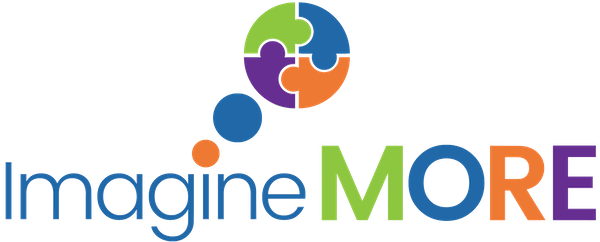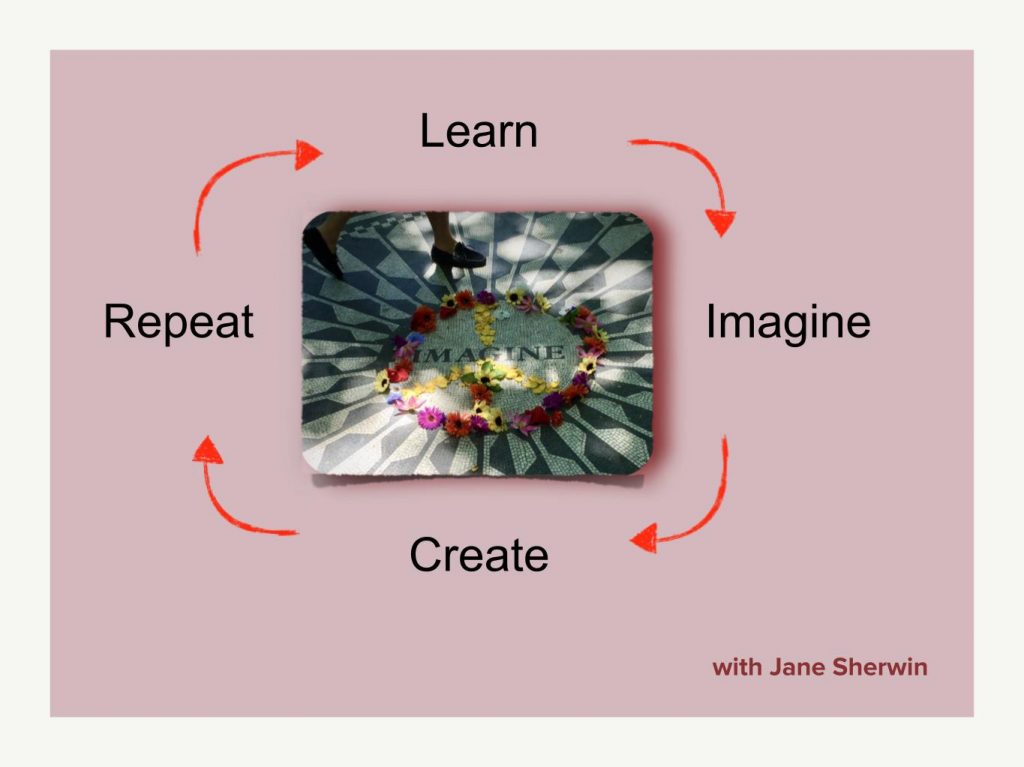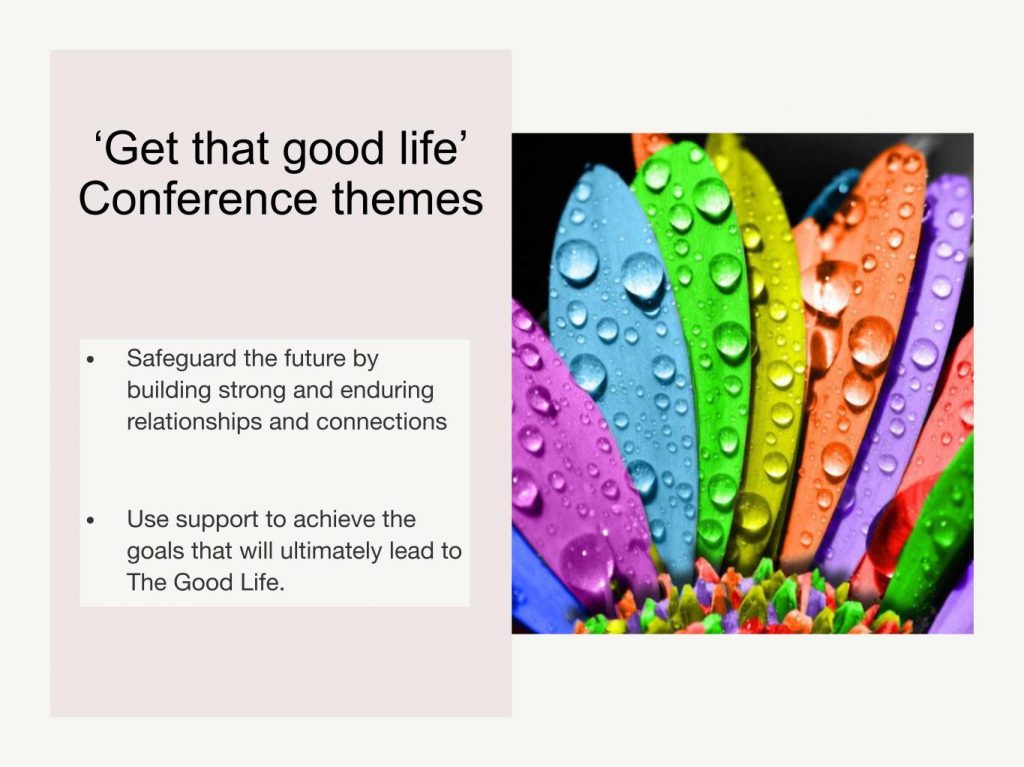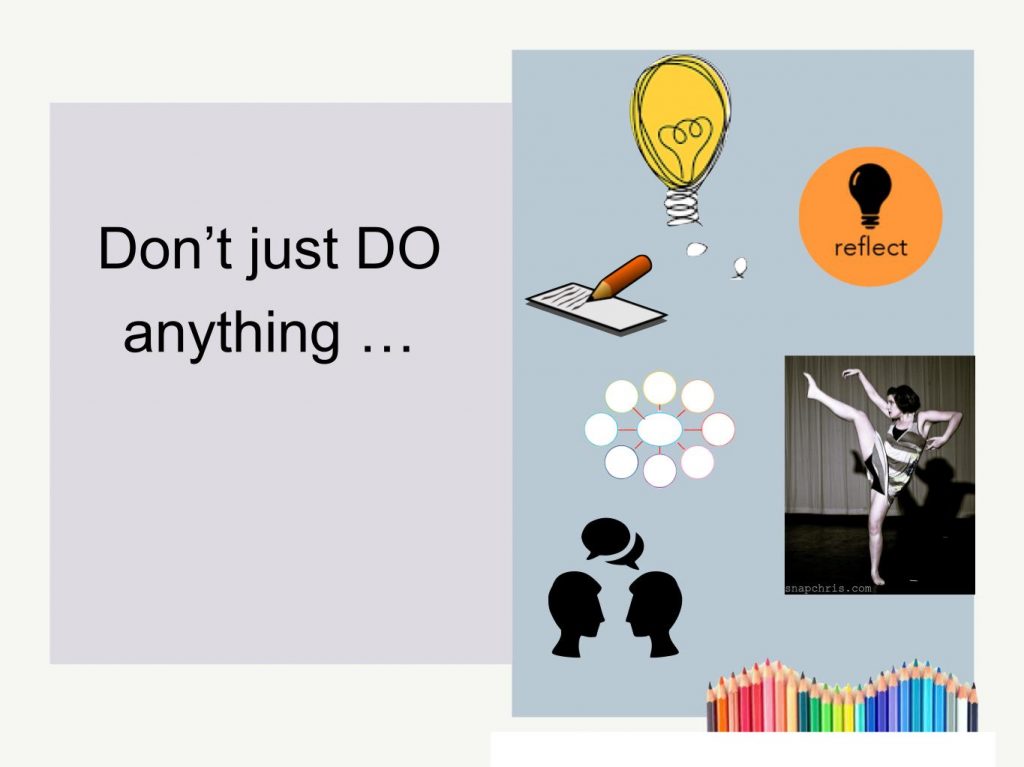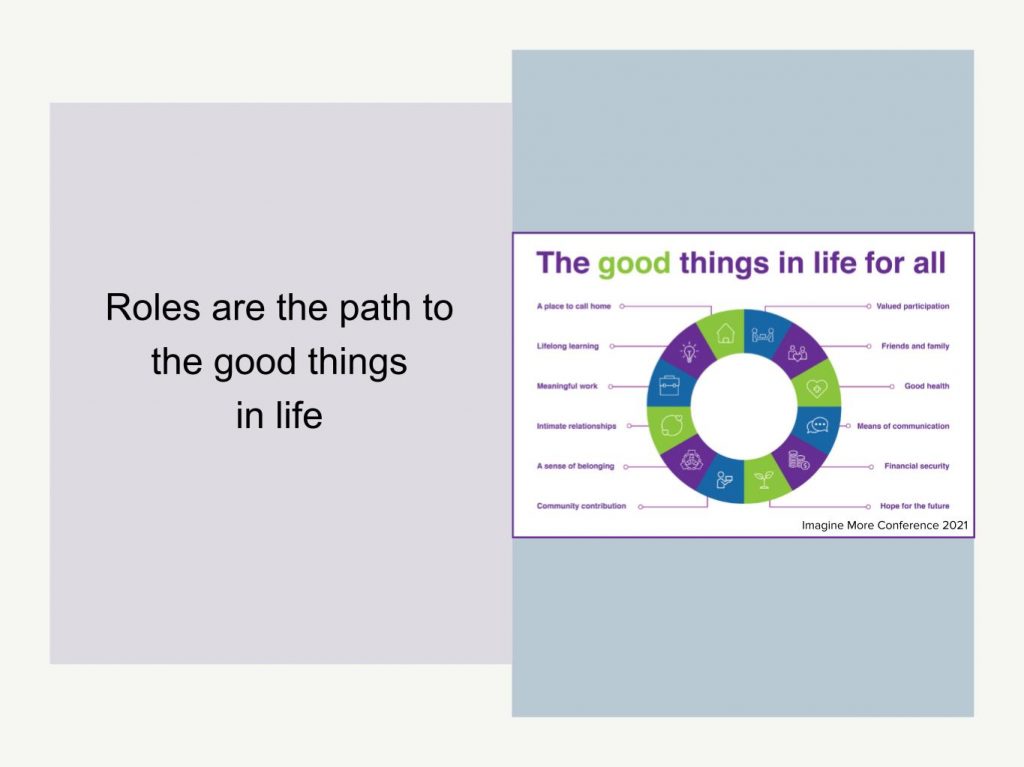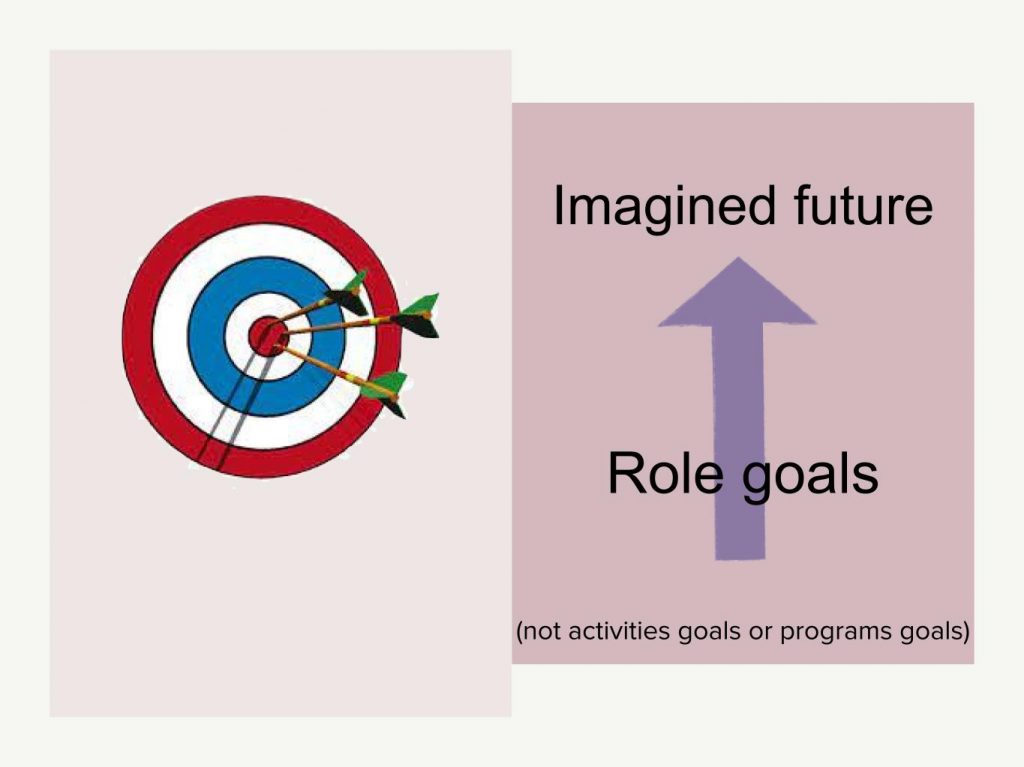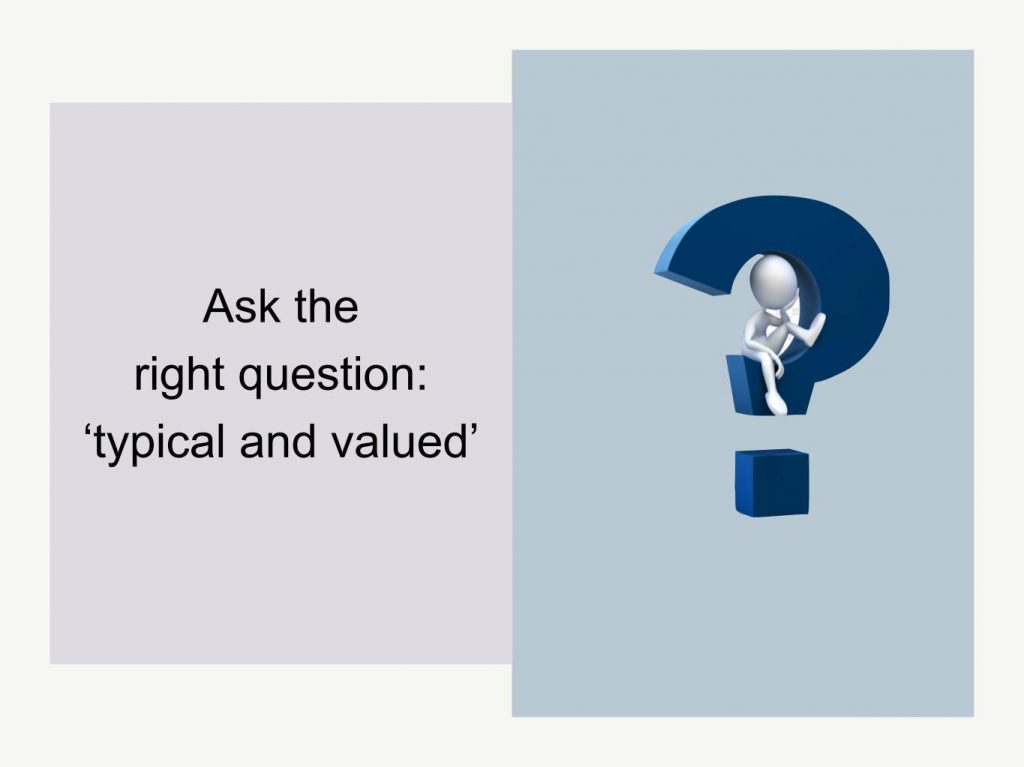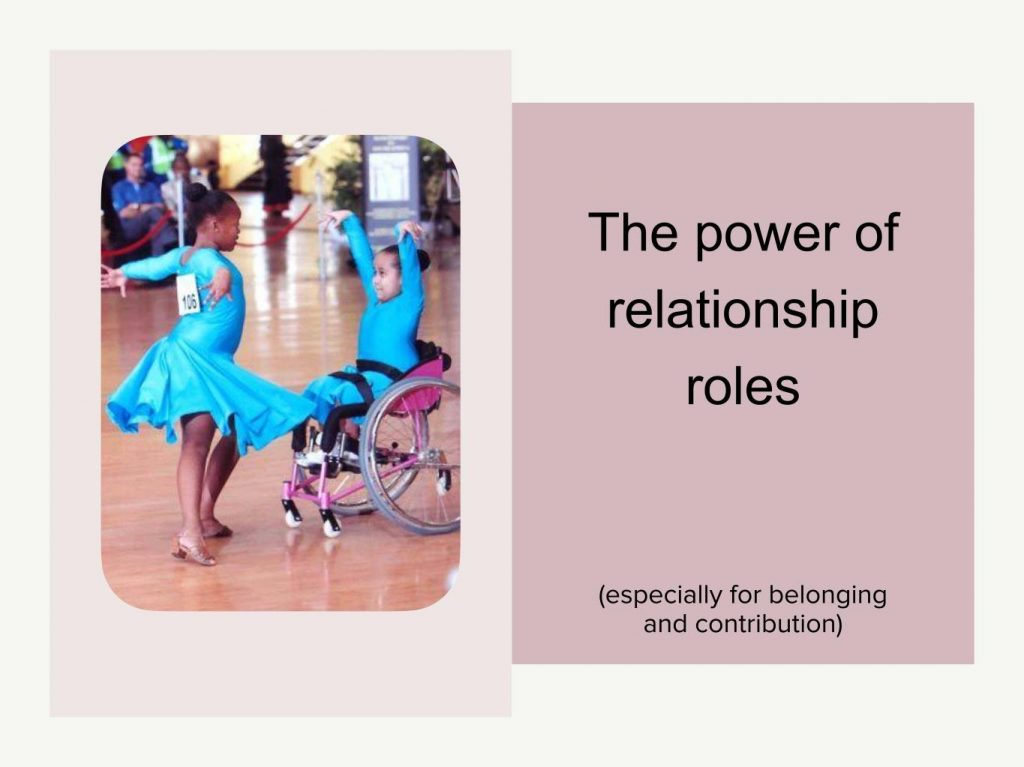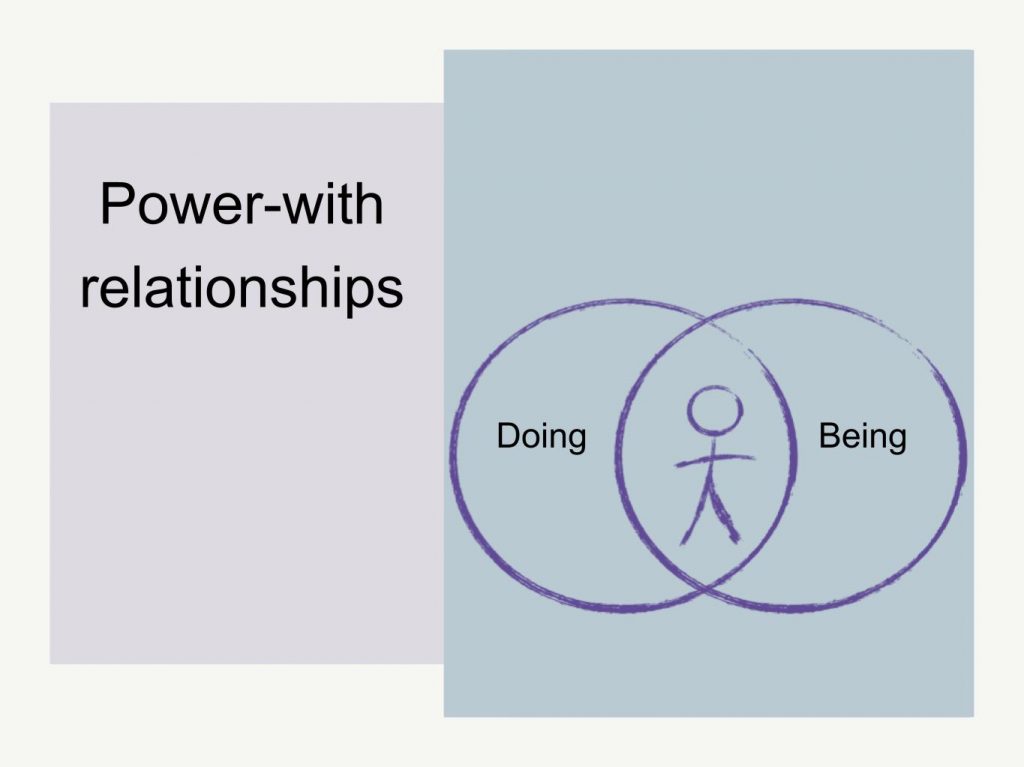This year, through our webinars, workshops, peer groups, and conference, we’ve shared lots of information about helping people with disability to enjoy the good life. Our website resource pages are filled with additional resources. Having so much information at your fingertips can sometimes feel overwhelming, and it can be hard to know where to start and how to make the best use of the ideas you’ve come across during the year.
Many people reserve some time after Christmas or in the New Year to look back and reflect on the year gone by. So we wanted to share a gift with you, hoping that it will help you and your family member with disability plan for a brilliant 2022.
Our gift is access to the final presentation of this year’s Get that Good Life! Conference. This session is called Learn. Imagine. Create. Repeat. Delivered by Jane Sherwin, it provides a framework to gather your thoughts after attending an event. While Jane references the conference, the framework is applicable to any event that has inspired you to take action.
Jane’s framework helps you think through:
- what you learned
- what you have or could imagine
- what you want to create
- what steps you will take towards making it a reality and
- then repeat the steps.
We’ll keep the recording online throughout December and January, and you can visit it whenever you wish. Enjoy!
Edited Transcription of Learn. Imagine. Create. Repeat.
Max: Hi, I am Max. I would like to tell you about Jane Sherwin. Jane lives in rural Queensland. She is a senior Social Role Valorisation (SRV) trainer. Jane has worked with many people with disability for over 40 years. Jane is the final speaker at our conference. She will talk to us about how we can use what we learnt over the past two days. I hope you enjoy listening to Jane.
Jane: Max, thank you so much for that introduction. I really appreciate it. And hello to everyone who’s watching or plans to watch in the future.
My paper is called Learn, Imagine, Create, and Repeat. But first of all, in the spirit of learning, I’d like to acknowledge those family members, individuals with a disability, and good workers who have gone before us and from whom we have learned. And they’ve been going before us for a very long time, at least from the ’80s, when more progressive forms of support were at last made possible for people.
So thank you for your past contributions, inspiring us, and helping us learn. As a result, we’ve had this fabulous conference for the last two days where there have been many great stories, good ideas, and so much to learn. So thank you to previous speakers and Imagine More for organising this.
How about over to you now, the participants. Given the quantity of information and good stories, how are you feeling? And maybe you could use chat for that. Thanks.
And maybe I should preface it by thinking that you might be wanting to say, “oh, there’s so much!”
So, how are you feeling?
- “Inspired”
- “Inspired and motivated.”
- “Ready to take action.”
I imagine some people are tired, and some people might be a bit overwhelmed. Some people are ready and raring and wondering where to start.
- “Impressed!”
I think a few of us have been sitting there feeling that way as well. However, you might be feeling impressed with where your own story is up to as well.
Well, let’s pause there, given that range of emotions that probably coexist in many of us.
And let me ask you, at the moment, what would be one message from the conference that you want to hold on to, that you want to make sure that you don’t forget? And there’s probably many. But if you could just choose one, that would be great.
- “There was a powerful message of ‘the ordinary life'”
- “To dream big” (great message!)
- “Put the person you support and their interests first.”
- “Look for valued roles.”
These were really strong, not just a one-off message, but quite a strong theme in the conference.
- “Hold a strong vision.”
- “You may not know how to get there.”
That’s quite an important starting point. And I remember hearing a similar message from a parent years ago about not knowing how to get there, but having the vision is the starting point.
Speaking of starting, let’s look at some of the next steps you can take following the conference.
As I mentioned before, the areas that I will cover are the importance of learning, imagining, creating, and repeating.
Learn
With so many messages, it is helpful to be grounded in the conference’s themes. And so the themes of the conference are
- to safeguard the future by building strong and enduring relationships and connections, and
- to use support to achieve the goals that will ultimately lead to The Good Life.
We can see that the conference spoke very strongly to those two themes.
So what have you learned that will help you safeguard the future and focus on relationships and connections? And also, how might you think or rethink how you use support?
If either of these two things is your intent, then much of the learning from this conference will be helpful.
You might be tempted to go off and do something real quick. I’m reminded of that saying, “don’t just stand there, do something”. Parents often say that to kids.
However, what I’m suggesting that you do is actually don’t do anything. Rather, as depicted in this slide, take some time and be with the learning.
So you might write, you might think, you might have some other ideas triggered for you, you might draw, you might talk to people, you might find like-minded others, you might start some initial personal planning in your own mind. And if you’re inspired to do interpretive dance, fantastic!
When you’re thinking about the learning, consider the learning from this conference, as well as learning from what you’ve been doing in the past. Consider things that you think have worked well, as well as things that haven’t done so well. So that learning phase is a combination of the now and the past.
Imagine
When you feel ready to start imagining a future, you might be:
- imagining big, a brand new future, or
- strengthening something that is already happening, but you’d like to see either more of it, for example, more hours of work, or more relationships, or deeper relationships.
- thinking about losing some things. For example, if someone is in a negative role, like a burden or the forever child, or a nuisance. You might want to lose perceptions of incompetence and a focus on deficit. Any of those sorts of things that you’d really like to see disappear, that too is part of your imagining into the future.
So this is an invitation to dare to hope, to dare to dream. And even lift up those “blinds in the mind” and consider what might something different actually look like, even if you don’t know how to get there?
One of the clear things, a strong message from the conference, is that the service life is insufficient, and has many costs. This is also a good opportunity to think about what mindsets you want people to bring to your table. What sorts of hopes and beliefs, values, attitudes, and perceptions will be important on the road to a better life or a good life?
Create
As you get ready to put effort into creating something different and better, then the bullseye is to think about valued roles. So valued roles are the path to the imagined future. It’s a powerful strategy. There’s a strong link between roles and a good life.
Here’s a beautiful image from the conference about the elements or features of a good life. It’s hard to, for example, have financial security without a valued role that gives that. It’s hard to enjoy good health without a valued role to get that. Having one’s own home, or work, or experiencing contribution, belonging, purpose, relationships, and so on. So that’s one of the key reasons for focusing on valued roles.
There have been so many roles mentioned in the conference across the two days. Can I ask you to write down in the chat one or two roles that have struck you as a valued role?
I kept count and noticed that about 20 roles were mentioned in the first half an hour to three-quarters of an hour of Day 1. Very powerful!
Some roles we saw included the worker role, the employee role, homemaker, presenter, introduction speaker, neighbour, school student, friend, Oztag player, intimate partner, and so on. It sounds like you’re getting a sense of what we mean by roles.
As Janet (Klees) said yesterday morning, often we think about activities rather than roles. We get stuck in filling people’s time with activities to occupy them or filling their time with programs. So there’s a significant distinction between a focus on activities and a focus on roles.
And as Janet said, a role will probably have the word “a” or “the” in front of it.
The key phrase when thinking about roles is to use ‘role goals’. There’s a lovely saying, “no goals without roles”. And so that leads us to think, well, what does a role goal look like? And it can actually be a very simple statement. There might be words in front of it, like “to be in the new role of…”.
Whatever your vision is, there’ll be roles embedded in that vision.
So if you want your child to go to the local school, “to be in the new role of local school student”, there’ll be some other roles too, like classmate, peer, learner, and so on. So if it’s new roles, it’s “to be in the new role of…”
If someone’s already got some valued roles, the role goal could be to strengthen the role of neighbour, for example. It intrigues me that so many people with disabilities these days live in neighbourhoods. Technically, they are neighbours but are often inactive neighbours. So “to be in the role of good neighbour” or “to strengthen the role of neighbour and good neighbour” could be a fine goal.
If the person is in valued roles already, there might be roles that you want to strengthen, such as the role of son or grandson. To strengthen the role of employee, your strategy will be gaining more hours, or more responsibilities, or whatever it might be.
If people have got valued roles and are in danger of losing them, then the role goal beginning would be “to maintain the role of…” Consider a scenario where there’s a high chance that a student might be evicted from the class or the school. In this case, the role goal is “to maintain the role of student”, or classmate, or whatever it might be.
What if the person is in some negative roles in terms of how they’re perceived and treated? In this case, it’s important to have a role goal of reducing or preventing those sorts of negative roles that do nothing for people’s status, or respect, or sense of a positive future.
A really strong focus of creating is to think about valued roles. And one way of formalising or semi-formalising these is to have role goals. And then there’s a whole host of other strategies, like writing the role goals down and sharing them. And certainly, take them along to any meeting with a funder.
Another helpful idea in the area of creation is to think about what your mental processes are. What’s the habit of thinking? For eons, the habit of thinking about the needs of someone with a disability has been to ask questions like where is
- the nearest special school?
- the sheltered workshop?
- a good group home?
- the local disabled bowling league?
- the local disabled scout group? And so on.
That habit of thinking is life-limiting because it will steer someone down the path of service life.
An alternative to that habit of thinking is to ask the question that we’ve heard numerous times during the conference: “how would anyone else do that?” I think it was in Annette’s session, early on day 1, when she and her husband asked the question, “Where would we find other three-year-olds?” This was a lovely example of asking questions based on what is typical and valued.
Putting those two words, ‘typical’ and ‘valued’, together is important because some typical things are actually not in the best interest of someone with vulnerabilities. For example, it might be relatively typical these days to have kids at school who talk back to the teacher or are disruptive in the class. You know the scene that I mean. So while that might be typical in that it occurs with frequency, it’s not valued. So in thinking about the valued role of school student, consider the activities and the expectations of the typical and valued school student.
The other thing to think about when using this principle of typical and valued is to add on. So think “typical and valued, and…” Some additional arrangements might be needed because of a student’s vulnerabilities, additional needs, or the imperativeness of what’s being attempted. So we saw in the fabulous video of Jocelynne, who has the dried fruit business at home, we saw all the adaptations to the house to enable someone who’s deaf and had some other challenges too, to live in her own place. And similarly, in Jack’s story, great examples of some adaptations or some additional things that were put in place. So think typical and valued, and what else is needed? That’s totally fine.
You can use this ‘typical and valued’ thinking in two phases:
- the imagining phase, so imagining a typical and valued lifestyle,
- the creating phase. What’s the typical place? What are the typical activities? What’s the typical and valued appearance? And so on.
I have a warning before I move on to the next slide. If we don’t think ‘typical and valued’, and if we only think ‘disability’, then what we get is a very narrow view of life and a narrow view of options. So this way of thinking s a way of broadening the sense of possibilities, even if it’s hard, because we don’t always know how to make it happen. It also might trigger other sorts of reactions.
Another thing to pay attention to in the creation phase is to be mindful of relationship roles and doing roles.
We’ve been reminded very strongly through the conference about the importance of relationships. Relationships keep people safe, and it’s essential to make sure there are people around as a safeguard for the future when other family members aren’t around anymore.
There’s another reason for paying attention to relationship roles. Through our doing roles and our relationship roles, we get a sense of who we are, and others get a sense of who we are as well. And those others are more likely to get a clue about how to relate to us through our roles.
So for someone with a disability who’s in the role of the customer at a shop, that gives clues about what sort of interaction might be desirable. If they’re in the role of employee, and look that part, and are doing an employee’s tasks, then whoever’s the customer knows how to relate to that person.
The other thing about having relationship roles is that relationships are the antidote to loneliness. When we look at the patterns of experiences of people with disabilities worldwide, loneliness is one of the key features. This is especially true if they’ve lived a separate life on the margins of society or even outside of local communities.
A friend and colleague, Meg Sweeney, talks about the range of relationships necessary in her daughter’s life. She says that for her daughter to live well, be safe, and have a good identity of multiple roles, she needs a great many social contacts, to have many acquaintances, to have several friends, to have a chance of an intimate relationship. So we need to keep an eye on the range of relationship roles and the depth of those roles.
So when you’re identifying the role goals, keep an eye on the doing type roles and the relationship roles.
The final suggestion to keep in mind is to examine the sorts of relationships that float around the individual with a disability. Let’s compare a power-with relationship with a power-over relationship.
In a power-over relationship, whoever’s enacting their power has this spirit of ‘we know best’. So in their use of power, they bring their authority, knowledge, experiences, position, access to resources, and so on.
It is possible, though, to be in a relationship where both parties bring experience, knowledge, access to resources, voice to that relationship, and so on. So scan the relationships between the worker and the individual with a disability, for example. Or it could be the whole service, including a school and the person with a disability. It could be between the service and the parent or other family members. It could be the relationship of the parent and the child. So in all relationships, both parties have power. The issue is who gets their voice heard and who doesn’t.
From the family’s perspective, the experience of a power-with relationship feels like people are on the same page and that they’re all heading in the same direction. They feel like the paid people have got the family member’s back or the family’s back. So, for people to experience that, we as workers, or whoever has the more powerful position or is using their power, must be really aware of what’s going on in our hearts and minds. What assumptions are we making about people’s potential, about their strengths, about their capacities, about who they are, about what the future might look like, about what’s good enough for them? Examining those assumptions is a good starting point.
We also need to be very mindful of our actions as well. I quite like how this image shows that in any relationship, there’s something about what is done, what’s transacted within that relationship. So whether it’s assistance with personal care or assistance to help someone to learn, they’re the ‘doing type’ aspects of the role.
But we also need to be mindful of how we are in the role. That’s what I was referring to when I spoke about ‘the assumption’ or what’s going on in our hearts and minds. Part of the doing and the being, especially, is the negotiation about the future and how to get there. And if role goals are used as the focus of the doing of a paid worker, then that gives the worker an agenda to work on. It gives them a sense of orientation to the future and what’s expected of them. So we’ve come full circle back to the value of role goals.
Repeat
So we’ll start to bring this presentation to a close now. Remember to
- take time to learn from where you’ve been the last two days and what’s gone before
- make intentional efforts to imagine, whether that’s a big imagining or a small imagining, painting that picture of the desirable future
- keep the importance of valued roles and using role goals in mind when you’re in the creation phase. But there’s also that habit of ‘think typical’. Keep an eye on relationship roles and keep an eye on the nature of the relationships you’re in. This isn’t so much about friend and family relationships. This is especially relevant when there are paid people involved in your life or the life of your family member
- repeat. These stories are often long stories. We probably all know of stories that have taken a decade before there was a glimpse of a decent, rich, meaningful, good life.
So take time to learn from where you’re at, so that you can imagine, well, what more do we want? Or what less do we want? In the learning phase, what’s worked? What hasn’t worked? What should we have more of? And so on.
So I’ll stop there. Thank you so much for this opportunity to share some thoughts with you. And I wish you all well in your getting that good life. Thank you.
Jan: Hi, Jane. Thank you so much for that. I think it’s just what we all needed to help us collect our thoughts. I know what it feels like to participate in a conference and get so many ideas! Sometimes you almost get paralysed with knowing what to do first.
I loved that saying, “lifting the blinds in your mind”. We probably all have them; some may be bigger than others! So it was thoughtful advice around how we can open up the opportunities out there and use serendipity to see those opportunities and do some thoughtful planning. But don’t think for too long!
Jane: No, that’s right.
Jan: I think this is where you might consider
- joining up with other people to have a bit of a conversation
- testing some ideas with people, and then
- take some thoughtful action.
And you may not always get it right, but learn from each action you take. So thank you so much, Jane.
Jane: My pleasure. Thank you.
